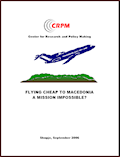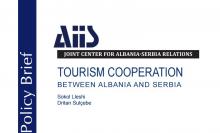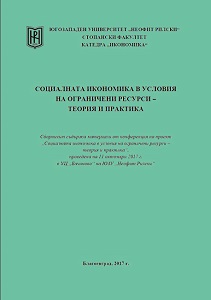
We kindly inform you that, as long as the subject affiliation of our 300.000+ articles is in progress, you might get unsufficient or no results on your third level or second level search. In this case, please broaden your search criteria.


Tourism is a powerful tool to bring different countries together.By better knowing one another,people of different cultures and backgrounds will find it much harder to generate feelings of hatred and animosity against each other. Thus, the consolidation of interaction in the area of tourism between Serbia and Albania is very important for the further stabilization of the relations between the countries, since it will not only trigger better economic prospects but it will also positively change the perception that both nations have towards each other.Both Albania and Serbia have concentrated in the last decade to promote a better image of their respective countries by branding themselves as attractive tourist destinations of the Southeastern Europe region.
More...
Bulgarian tourism is one of the important industries for the development of the Bulgarian economy. In order for each industry to operate, it needs motivated staff, motivation not only for pay, but also for a number of other social factors such as continuing education, working conditions, additional health insurance, etc. It is the legal possibilities for doing so additional incentives are the subject of this text.
More...
This book is funded by the Project "Development and Testing of a Model for Monitoring and Assessment of Sustainable Tourism Development in Bulgaria (Following the Example of National Resorts)", funded by the Research Fund, under Contract No. KP-06-H25 / 3 from 13.12.2018 and is intended for both undergraduate and master students studying tourism at various universities, business and geographical faculties in the country, as well as for teachers and experts in tourism, tourist organizations, institutions and entrepreneurs in the field of tourism. tourism. It is also a useful practical guide for local authorities and tourist area management organizations in the country.
More...
35 praktičnih naputaka za spas turizma u uvjetima zdravstvene krize. 1. Ako vas muče visoka temperatura, bol u mišićima, kašalj i grlobolja, to nije razlog da Dragom Gostu ne servirate doručak. 2. Ako Dragoga Gosta muče visoka temperatura i bol u mišićima, a uz to i napadno kašlje, to nije razlog da prema njemu budete rezervirani: svaka nacija ima pravo na svoju kulturu i običaje, a susret s istima može vas samo obogatiti.
More...
Medical tourism is one of the forms of tourism with dynamic development in recent years. To determine the strategic development of the area, it is necessary to determine the strengths of the destination with regard to trends and opportunities that the market offers. The aim of this paper is to identify the competitive advantages of the Czech Republic in terms of medical tourism and answer the key question whether the Czech Republic has the prerequisites for future development. The evaluation was performed on the basis of a comparison of research reports of the Czech Tourist Board (CzechTourism) with international reports evaluating the competitiveness and position of the Czech Republic, namely the country reports of the International Medical Travel Journal, Euro Health Consumer Index, Travel and Tourism Competitiveness Index. Furthermore, the services offered for foreign tourists were evaluated. A price comparison of selected procedures was also included. Based on the analysis, the competitive advantages of the Czech Republic were determined. The identified competitive advantages show that the Czech Republic has good potential for the development of medical tourism. Based on a comparison of the main final reports of foreign and domestic organizations, it follows that the main competitive advantages of the Czech Republic in the field of medical tourism are almost zero waiting times and low cost of quality medical procedures and quality medical care.
More...
The aim of the performed analysis was to identify and compare traces of destination and event management based on a historical analysis of dominant regional entities, specifically JZD Slušovice and its activities in the 1980s. Regional analyzes rely on a wide range of tools. Historical comparison is a method that allows to identify and modify "already known". Based on this method, historical precedents of destination and event management were identified, especially links between dominant regional subjects and interests determined on the basis of political and social, artificially created concepts, applicable also to contemporary destination and event management. An economic calculation using the "German tank problem" method (Goodman, 1954) proved the importance of computer production in the JZD Slušovice, the subsequent economic prosperity created a background for "nonproduction" activities. The identified targeted influencing of the social and cultural development of the region (by an economically dominant entity) can be meaningfully compared with the forms of current destination and event management. Due to the unavailability of statistical data from the analyzed period, the data were taken from contemporary sources, or from references to these sources, it was not always possible to verify the data.
More...
The paper discusses the non-mandatory elements of spatial planning and their role in strategic management. These, if properly shaped, can result in effective urban policy. The described individual components are necessary exaggerations and planning provisions that are most often absent from the formal documents, although they should be included as arguments to support the choices made by the local government authorities. Operational planning elements are essential in today’s urban management process. The most important of these include: (1) defining objectives in planning acts or their amendments, so that the documents are not just a formality, but can also be useful as an effective starting point for spatial operational policy; (2) identifying priorities, i.e. outlining the sequence of events; (3) coordination between parallel, social, economic and business activities, which should be mutually beneficial as a result of planning decisions. It is also important to have transparency when transferring the overall development goals into simple activities that, if executed together and in the right order, can produce the effects of a clear transformation of the urban space. These activities should be a component or a direct result of each planning study, regardless of its scale and impact. This chapter points out the optional elements of planning, using the city of Lodz as an example, indicating the direction of the city’s development based on a consciously chosen model of transformation, defining time perspectives and the zoning and sequence of investment activities. It also draws attention to the need to devel-op and implement greenery planning standards, identify local places of social integration, and achieve small potentials in the urban spatial policy.
More...
Purpose: The chapter explores the resilience of Poland’s economy to external shocks, focusing on the tourism sector. It aims to compare the impact of various crises, such as the financial crisis, sovereign debt crisis, COVID-19 pandemic, and the war in Ukraine, on tourist arrivals in Poland, Lithuania, Spain, and Portugal. Design/methodology/approach: Employing a Vector Autoregression (VAR) model and Impulse Response Functions (IRFs), the study analyses the effects of these crises on Gross Domestic Product (GDP) and foreign tourist arrivals (ARR). Data from the Eurostat Dissemination Database, spanning from Q1 2006 to Q4 2022, is used, with adjustments for seasonality and crisis-specific dummy variables. Findings: The research reveals notable differences in how these economies, with varying tourism dependencies, respond to external shocks. Tourism-dependent countries like Spain and Portugal exhibited greater sensitivity in their GDP and ARR to these shocks compared to less reliant countries like Poland and Lithuania. Research limitations/implications: The study’s scope is limited to four European countries and specific crises, suggesting the potential for broader future research. Practical implications: The findings offer valuable insights for policymakers and tourism industry stakeholders, aiding in the development of strategies for crisis mitigation. Social implications: The chapter underscores the importance of resilient economic structures and policies in mitigating the broader social and economic impacts of crises. Originality and value: This chapter provides unique insights into economic resilience in the tourism sector during crises. Its comparative analysis across different European countries offers valuable perspectives for economists, policymakers, and researchers in understanding the dynamics of economic resilience and crisis management in tourism-dependent economies.
More...
Purpose: The aim of this chapter is to empirically verify the thesis (set out in the previous work) regarding the substitution changes in the tourism market caused by the COVID-19 pandemic. The question was posed as to whether the travel substitution caused by the pandemic concerned substitution internal or external to the offer of the tourism market. Design/methodology/approach: Qualitative research was conducted on the supply side and the demand side of the tourism market. The supply-side research comprised a direct (non-standardised) interview among representatives of the three main tour operators organising tourist trips on the Polish market. The demand study used a direct standardised interview method using an interview questionnaire. Findings: The results of the research showed internal substitution processes in the tourism market triggered by the COVID-19 pandemic. The changes affected trips to a slightly greater extent in 2020 than in 2021. The research showed lower external substitution, meaning that during the pandemic consumers did not want to give up tourism trips. Research limitations/implications: The research confirms the findings of other authors that the pandemic treated as a transformative force in tourism and hospitality, while the relatively short time after its end prevents long-term conclusions. Practical implications: The results can be used by service providers, to anticipate changes caused by contingencies, as well as to predict trends in tourism product design. Social implications: The research indicates the direction of change that a pandemic may provide a starting point for further observations. Originality and value: Most of the analysis is limited to quantitative phenomena related to the reduction of tourism trips as a result of the COVID-19 pandemic. The originality of the article is based on the analysis of the substitution processes in the tourism market by internaland external substitution. The added value is the simultaneity of the study on both the demand and the supply side of tourism.
More...
The article reports on the discussion on “Who needs tourism (to be happy?)”, conducted by participants at the XXXIX Seminarium Terenowe national conference, “Warsztaty z geografii turyzmu”, which took place in Łódź on 22–23 September 2023. During the debate, attention was paid to the benefits of tourism development for various entities: tourists, tourism entrepreneurs and residents of the visited areas. The title question was also addressed to ChatGPT.
More...

Obesity is one of the chronic diseases. It is a major problem not only for health but also for society. Problems associated with obesity not only contribute to the development of various health complications, but also have negative consequences on quality of life and well-being. There are many forms of tourism and recreation that can be used to help treat obesity and offset its psychosocial effects. Therapeutic forms of tourism and recreation can contribute both to improving physical fitness and circulation, as well as lowering body weight, but can also significantly improve mood, raise self-esteem and thus restore a sense of being a full member of society. The study used a survey method which covered those struggling with obesity. In the light of the research, there seems to be a lack of education regarding the therapeutic value of tourism and recreation. The study showed that such people are mostly unaware of the benefits that can come from practicing dedicated forms of tourism and recreation.
More...
The aim is to analyze the free time of patients at Wieniec-Zdrój Spa, located in the Kuyavian-Pomeranian Voivodeship. The research interests include issues such as patients’ free time, its quantity and method of use. The free-time behavior of patients on rehabilitation was observed, both in the spa area and during sightseeing trips. An important element was the classification of the activities of patients and the creation of an original typology of residents visiting health resorts. The research shows that the tourist and recreational activity of patients is diverse and depends on many factors, as residents try to spend their free time actively. The following research methods were used: a diagnostic survey (the tools were a survey and interview questionnaire), participant observation and photographic documentation.
More...
This article outlines the subject of the Kuyavian megaliths located in the Kuyavian-Pomeranian region of Poland. The basic concepts were explained, the origin and history of the tombs were described. Then, the process of creating an interactive map of the megaliths located in the cultural parks in Wietrzychowice and Gaj Stolarski and in Sarnowo was presented. The StoryMaps application was created on this basis.
More...
The city of Kołobrzeg is the largest health resort in Poland and at the same time one of the most important tourist centers (along with Warsaw, Krakow and Tricity). The volume of recorded tourism results from the exceptionally intense concentration of accommodation facilities and the level tourist colonization reached. In the light of research conducted in Kołobrzeg, part of the area of tourist colonization subspace is being transformed into tourist urbanization subspace. Research on the process of transformation required the use of detailed geodemographic data regarding the location of registration addresses and the distribution of population according to statistical units and census districts. The obtained geodemographic data are consistent with the issues of research on the scale of the expansion of the tourist accommodation base, as well as the location and use of existing housing and apartment resources across time. This has made it possible to geolocate places and areas of registration for residents and examine changes in the population distribution for nine districts in the years 2017–2023. As a result of the detailed research, an attempt is made to extrapolate the expansion of Kołobrzeg for residents and possible changes in the capacity of tourist accommodation: 2023–2035. The results confirmed changes to tourist space and the progressive functional specialization of individual districts. It should be emphasized that ongoing changes in its tourist space are closely related to changes in the city’s socio-economic profile and its functional transformation. Kołobrzeg is therefore a very interesting case study of the rapid socio-economic development of a previously monofunctional medium-sized settlement which, despite the negative effects of the COVID-19 pandemic and changes taking place in the socio-economic and political environment (e.g. the war in Ukraine), is constantly expanding its importance on a national scale and in particular in Central and Western Pomerania.
More...
The aim is to present, discuss and compare methods of managing social media profiles (Facebook and Instagram). Five-star hotels in Gdańsk were selected for the research and prove that the basis for managing an effective social media profile is consistency, proper promotion and clarity of publication, and that these have an impact on the results achieved. Data collected from hotel profiles on social media were collated, compared and analyzed. Based on the collected information, the engagement rate was calculated, allowing for an objective assessment of how the content published by the profiles is perceived. The aspects discussed in the article were intended to show what mistakes hotels make in managing their social media profiles and how they can mitigate them.
More...
The article aims to analyze an issue in tourism semiotics – the interpretation of selected natural signs that travelers may encounter during their journeys. In many cases, tourists fail to react appropriately to natural signs, even those indicating health or life-threatening hazards. They have not got into the habit of reading signs that inform them about risks and guidelines for dealing with them. Due to the sense of carefreeness during vacations, tourists often passively await a reaction from tourism organizers, who then face the challenge of taking actions tailored to the different abilities of tourists to interpret signs, as well as the lack of standardization of some associated symbols. The selection of signs for analysis is subjective, based on observations made during tourist trips, work with tourists and tourism students. It also relates to current issues as climate change.
More...
The article focuses on the presentation of astronomical tourism and its potential in Poland, as well as the example of Gwiezdne Dolistowie in the Bieszczady Mountains. It also outlines the activities that can be undertaken to practice astro-tourism and presents some unknown concepts in the field. The results of surveys conducted among the guests of the facility and random individuals, gave the most reliable basis for assessing the potential. The article formulates the author’s definitions: astro-tourism farm, astro-tourism product, astro-tourism potential.
More...
The aim of the article is to present the development of tourism in the Chernobyl Exclusion Zone and to answer the question why this place has become a tourist attraction. A form of tourism called ‘dark tourism’ will be described. Then the effects of the disaster at the Chernobyl power plant and how this event has become the basis for the transformation of the Chernobyl zone into a tourist attraction will be presented. By analysing research on those who have travelled to Chernobyl, the type of tourist and their motivations for travelling to the exclusion zone will be given. Statistical data showing the development of tourism is analyzed and the offers of travel agencies presented. Specific rules related to traveling to this place are also described.
More...